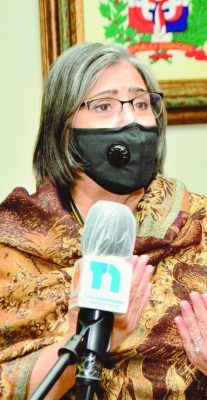
The president of the National District Electoral Board, Dalma Cruz is confident the winners of the 190 seats in the Chamber of Deputies will be known this coming week. The Central Electoral Board (JCE) has already announced the results of the presidential and senatorial races, yet the vote count for the Chamber of Deputies is behind schedule. “We are working on finishing the vote count as soon as possible, you can be sure of that,” said Cruz, who said both political party representatives and board staff have been working up to 15 hours a day.
In addition to the National District, there are also major differences in the vote count for Santiago’s deputies.
The Presidency and the Senate are determined by who gets the most votes. Yet, the winners of Chamber of Deputies seats are subject to the D’Hondt method. This means the votes are first allocated to the corresponding political party and then they distributed among the candidates of that party who have the most votes.
“It can happen that a candidate for deputy from a small party can get more votes than a candidate with fewer votes from a large party and the system allocates the vote to this candidate. This is because part of the votes of the most voted candidates from the large parties end up added to those who get less,” sociologist Domingo Matías explained in an interview with Diario Libre.
The count of the Chamber of Deputies votes has also been affected by what Cruz has called the basic deficiencies in mathematics on behalf of thousands of people who had to do the tallying of the numbers. This has required extra time and staff to verify and validate these results, especially in the larger voting districts and where votes were highly contested. Teams of delegates from the political parties and young civic observers have participated in verifying and validating the results.
As of the past weekend, it is now known that a lot of “errors” originally attributed to deficiencies in the arithmetics of the delegates, could instead have been attempted fraud in the vote count at the chamber of deputy level. El Dia says that it is now being determined that zeros and ones were added to several of the tallies, especially in large cities.
The media says that much of the scrutiny of the votes is thanks to the participation of Jose Horacio Rodriguez who ran for District # for the Alianza Pais ticket. People followed how despite receiving the most votes, he still could be deprived of the seat and young observers monitored the vote count and the revision and validation efforts closely.
The D’Hondt method, also known as the Jefferson method, is a highest averages method for allocating seats. It is a party-list proportional representation system. Wikipedia explains that method was introduced in the United States by Thomas Jefferson as a method for proportional allocation of seats in the US House of Representatives. The method got its name after Belgian mathematician Victor D’Hondt described it in 1878 in Europe.
In the Chamber of Deputy election, an open list form was used in which voters’ choices determine the order. Previously, a closed list had been used whereby each political party selected the order of election of their candidates.
Following up on the vote count, local media has carried reports on the arrest of Fidel Cornelio, son of ruling PLD party deputy Cleo Sánchez, accused of altering the results at polling stations in the National District. A video evidenced the alteration. The case was denounced by independent electoral observers representing the Country Alliance (AlPais) political party and the movements Guardianes de la Democracia and Bien Comun. The observers protested that the adding of zeros had affected the vote of their represented candidate, Jose Horacio Rodríguez. The media said that Fidel Cornelio was later released without charges.
A preliminary vote count for the Chamber of Deputies indicates that as of the morning of Monday, 13 July 2020, none of the political parties will have majority in the chamber. Of 190 seats, 167 seats have already been allocated to political parties. This is: 81 are to go to the 81 Modern Revolutionary Party, 67 to the Dominican Liberation Party, 4 to the People’s Force (FP), 3 to the Social Christian Reformist Party, 3 to the Dominican Revolutionary Party, 2 to the APD, 2 to the Frente Amplio. It has been reported that the BIS, PRL, PHD, PRSD and PPC minority political parties each will have one seat.
What is known is that the Chamber of Deputies is getting an overhaul after 16 years of being under the control of the ruling Dominican Liberation Party (PLD) that had maintained 106 of the 190 seats. The PLD also has majority in the Senate until 16 August 2020.
As reported, as of Monday, 13 July 2020, the electoral authorities had yet to decide on 23 deputy seats. Dalma Cruz of the National District electoral board says that they have validated 75% of the vote for district #1, 74.5% for district #2 and 59.54% for district #3.
Read more in Spanish:
Diario Libre
Hoy
Hoy
N Digital
Hoy
Listin Diario
Diario Libre
Diario Libre
El Dia
El Dia
Hoy
Somos Pueblo
Acento
13 July 2020

